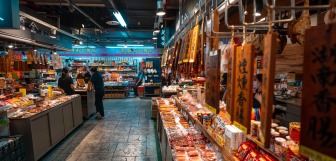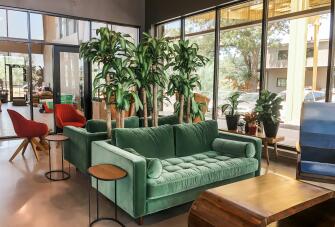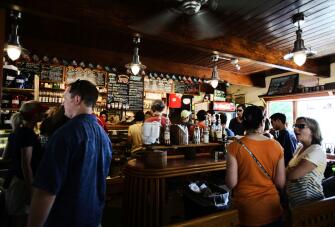Retail Location Strategy: Maximize Your Store's Potential
Don't worry. We've got you covered. This blog post will dive into the ins and outs of retail location strategy and give you all the tips and tricks you need to make your store a success. From understanding the impact of online shopping to creating a unique retail experience, we'll cover it all. So, grab a coffee, and let's get started on maximizing your store's potential through an effective retail location strategy.
What is a retail business?
A retail business is a business that sells products or services directly to the consumer. These businesses typically operate in a physical location, such as a store or a market stall, but can also sell online.
Retail businesses can be found in various industries, including fashion, electronics, groceries, and home goods. Some examples of retail companies include department stores, clothing boutiques, and convenience stores. The goal of a retail business is to sell products or services to consumers in exchange for a profit.
Types of retail businesses
There are several types of retail businesses, each with its own unique selling points and target customer base. Shopping centers or department stores, for example, offer a wide variety of products and services under one roof, making them a convenient option for consumers who want to find everything they need in one place.
On the other hand, specialty stores focus on a specific product category or niche, such as electronics or Apparel. Supermarkets are retail businesses that focus on selling food and household goods, while online retailers operate exclusively through the internet and do not have a physical location.
How retail businesses make money
Retail businesses generate revenue through the sale of goods and by charging a markup on the products they sell. The markup is the difference between the cost of the product and the price at which it is sold. Retailers also make money through product repair, installation, and warranties.
Choosing the right location
When it comes to your location strategy, choosing the right retail location is critical. The location of your store can have a huge impact on your success in the retail industry.
According to Shopify, 81% of Gen Z consumers in the US prefer to shop in a physical retail space to discover new products.[1] So, how do you choose the perfect spot for your retail business? Here are some key factors to consider when selecting a retail location:
Foot traffic:
55% of brands also say winning customer traffic is a top challenge. [2] So, it's arguably one of the most important factors when choosing retail locations. The more foot traffic a location has, the more potential customers you'll have. Look for sites with high pedestrian traffic near busy intersections, public transportation, or popular shopping centers.
Competition:
Another important factor to consider in your retail location search is the level of competition in the area. Too much competition can make it difficult to attract customers, while too little competition can make it hard to generate sales. Try to find a balance by looking for areas with complementary retailers rather than direct competitors.
Demographics:
Understanding the area's demographics is also crucial when choosing a retail location. Consider factors such as age, income, and lifestyle of the area's residents. These factors will give you a good idea of what products and services will be in demand in the area and will help you strategize your retail business.
By considering these factors, you'll be well on your way to choosing the perfect retail location for your business. Remember, the key to success in the retail industry is to select a location that will allow you to reach your target customers.
The Impact of online shopping
In today's digital age, the rise of online shopping has dramatically impacted the retail business world. Consumers now have access to a wider range of products and services than ever before, and can easily compare prices and reviews from the comfort of their own homes. As a result, brick-and-mortar stores are facing increased competition from online retailers. However, location strategy can help retailers compete with online retailers.
One way retailers can utilize location strategy is by focusing on convenience. By choosing a location easily accessible to consumers, retailers can make it easier for customers to purchase products in-store rather than online. In addition, retailers can also use location strategy to offer unique and personalized experiences to customers, such as in-store events, personalized service, and engaging store design. (We’ll discuss those in the next section of this article!) All these strategies can help drive store sales and increase customer loyalty.
However, it's important to note that the location of a store is also a major cost factor. Choosing a high-profile location may increase the chances of attracting customers, but it also increases the cost of rent and other expenses. Retailers must weigh the potential benefits of a high-profile location against the additional costs.
By understanding the impact of online shopping and using location strategy to compete, retailers can drive store sales and increase customer loyalty.
Creating a unique retail experience
Creating a unique retail experience is crucial for attracting customers and driving sales in today's competitive retail industry. A retail store that offers an engaging and personalized experience is more likely to attract customers and generate repeat business. Here are some strategies for creating a unique retail experience:
- Personalized service: Provide excellent customer service by hiring friendly and knowledgeable staff who can help customers find what they're looking for and make recommendations.
- Hosting events: Hosting in-store events such as product demonstrations, workshops, or book signings can create a sense of excitement and attract customers, and are some of the most popular unique retail experiences.
- Engaging store design: Create an engaging store design that reflects your brand and makes customers feel welcome. Use lighting, color, and layout to create a welcoming atmosphere.
- In-store technology: Implement in-store technology such as interactive kiosks, digital displays, or mobile apps to enhance the shopping experience and make it easier for customers to find and purchase products.
- Community engagement: Building a sense of community by engaging with your customers through social media, hosting loyalty programs, or offering personalized services can help drive sales and customer loyalty.
Measuring success
Measuring the success of your retail location strategy is crucial for understanding what is working and what isn't. By tracking key metrics, retailers can make data-driven decisions to improve their retail store's performance.
Here are some key metrics to track:
- Sales: One of the most important metrics to track is sales. By monitoring sales data, retailers can track how their store is performing and identify areas for improvement. (A good pos system for clothing store can be very helpful with this!)
- Foot traffic: Tracking foot traffic can give retailers an idea of how many customers visit their stores. This can help retailers understand how their location is impacting customer traffic.
- Customer satisfaction: Customer satisfaction is another critical metric to track. By monitoring customer satisfaction, retailers can understand how their store impacts customer experience and identify areas for improvement. This could be tracked through customer feedback surveys, usability tests, customer conversations, website analytics, focus groups and on social media - utilize a few of these to get the best overview of your customer’s satisfaction.
- Return on investment (ROI): Retailers should also track their return on investment to understand the impact of their location strategy on their bottom line.
- Marketing campaigns: Retailers should also track the success of their marketing campaigns and how they impact their sales and customer traffic.
By tracking these key metrics, retailers can make data-driven decisions to improve their retail store's performance. And by understanding what works and what doesn't, retailers can replicate their success stories across different locations, products, and services.
Embrace the power of the Complete Solution
The Epos Now Complete solution was designed with businesses in mind. Take advantage of features such as advanced inventory management, payment processing services, and a suite of award-winning apps.
How a retail POS system can help your store
A retail POS system, or point-of-sale system, can be a valuable tool for retailers looking to improve their location strategy and boost sales. Here are some ways a retail POS system can help:
Payment processing service
A retail POS system allows retailers to easily process payments, including credit and debit cards and mobile payments. This can help speed up checkout lines and improve the customer experience.
Track sales data
A retail POS system can help retailers track sales data, including sales totals, inventory levels, and customer information. This data can be used to make data-driven decisions to improve store performance.
Enhance marketing efforts
A retail POS system can also help retailers enhance their marketing efforts by collecting customer data, such as email addresses and purchasing history. Retailers can use this data to create targeted marketing campaigns and improve customer engagement.
Improve inventory management
Retail POS systems can also help retailers improve inventory management by tracking inventory levels and identifying slow-moving or out-of-stock products. This can help retailers make better purchasing decisions and ensure they have the products customers want.
Provide customer support
A POS program can also provide customer support by tracking customer purchases and providing an easy way to create loyalty programs and discounts.
Final Thoughts
In conclusion, retail location strategy plays a crucial role in the success of a retail business. From choosing the right retail locations to creating a unique retail experience, retailers must make strategic decisions in order to attract customers and drive sales. By understanding the impact of online shopping, tracking key metrics, and utilizing tools such as retail POS systems, retailers can make data-driven decisions to improve their store's performance. Additionally, the importance of location can't be overstated.Retailers have to be mindful of foot traffic, competition, demographics, and cost.
Retail businesses come in different forms, from department stores to specialty stores, supermarkets, and online retailers, each with its own unique selling points and target customer base.
Ultimately, a successful retail location strategy requires careful planning, data analysis, and strategic decision-making. By following the tips and tricks outlined in this blog post, new retailers can maximize their store's potential and drive sales, making their retail space a success.
Want to learn more about opening a retail store? Check out our retail blog posts below!




